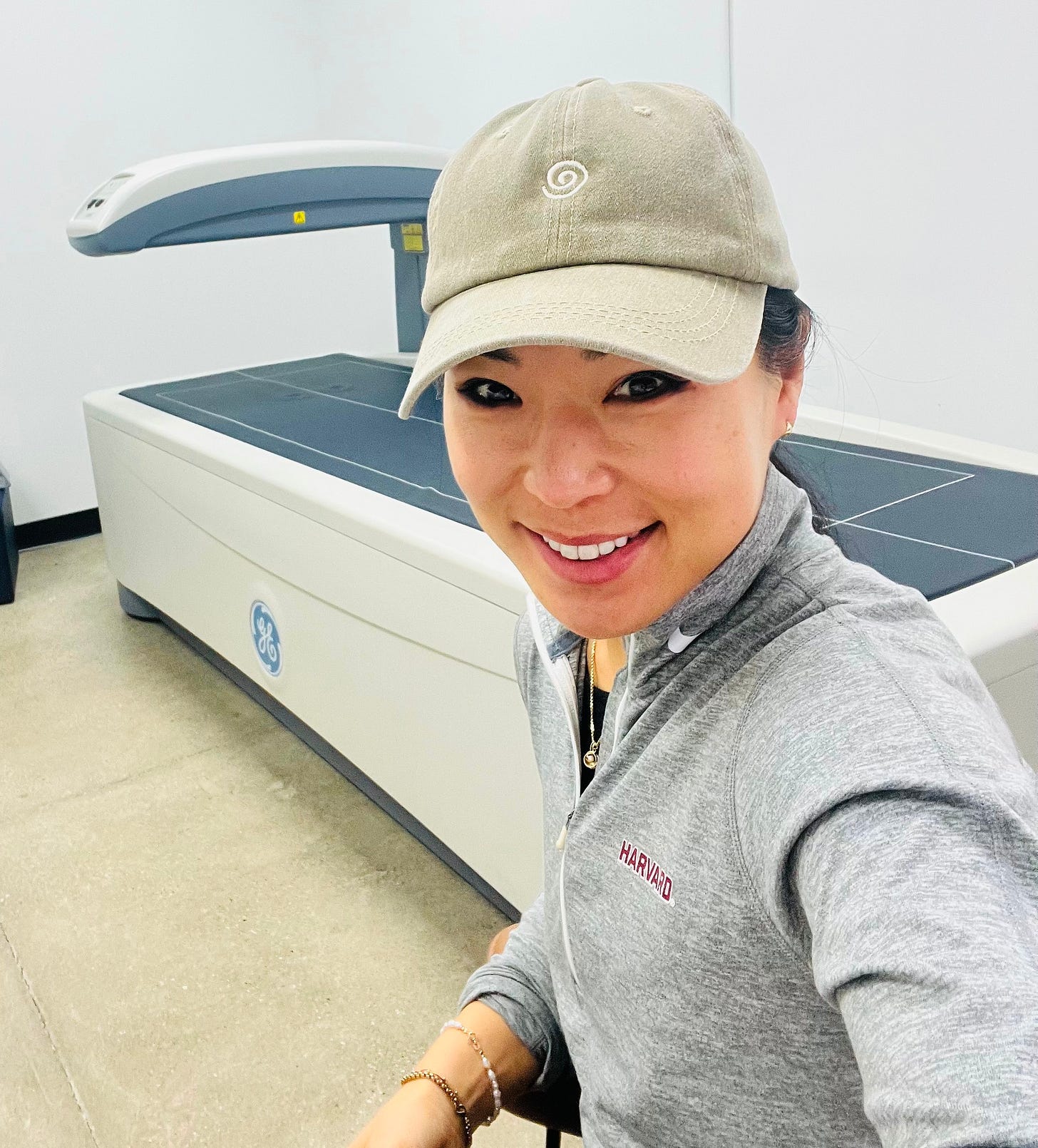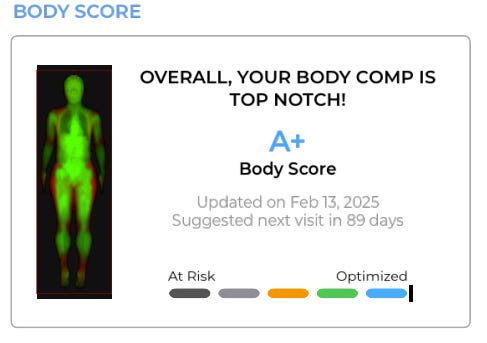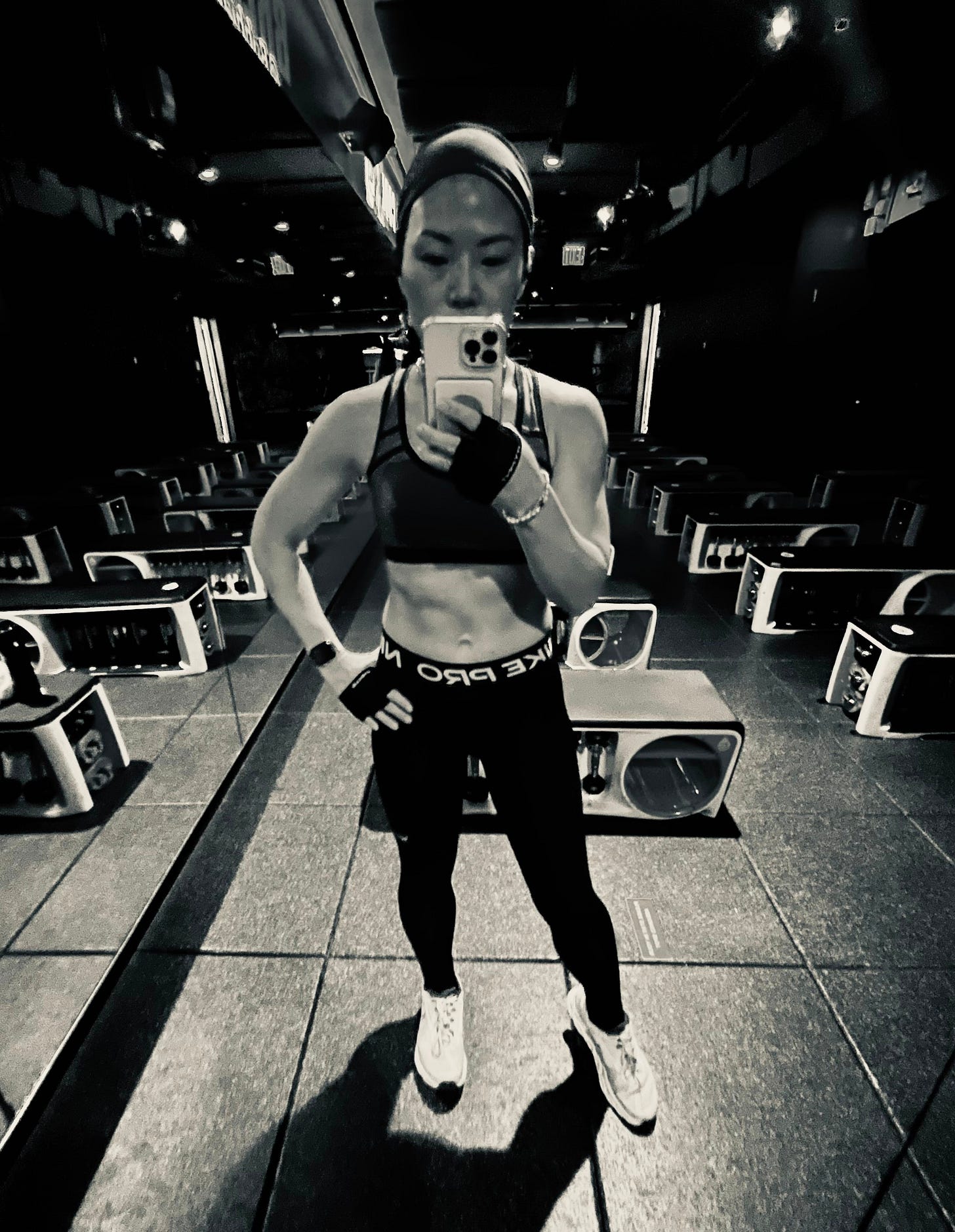Disclaimer: The following is not medical advice but a sharing of my health journey. If you decide to pursue a new health plan, please consult a medical professional to create one that is best for you.
Can I gloat for a moment?
I recently accomplished a 2025 goal: to create a more robust baseline of my physical health, specifically bone density, muscle mass, visceral fat, and cardiovascular function. If this list seems different from typical physical goals lists you see, such as weight, BMI, or clothing size, it is because these are invisible metrics that we rarely discuss in a society obsessed with appearances, particularly women's. However, as a woman in her 40s facing significant health changes this decade will inevitably bring, invisible metrics are just as, if not more important than, visible ones. In addition, many visible results reflect improvements in invisible metrics, while the converse isn't always true. More importantly, these invisible metrics are more direct indicators of health outcomes.
While accomplishing this goal didn't require more effort than making an appointment for DexaScan, RMR (resting metabolic rate) test, and VO2Max, the most challenging hurdle was working up the courage to face whatever the results were. Without these numbers, getting complacent about your health is easy if you have a reasonable daily routine, a clean annual health exam, and clothes that fit okay (probably the dryer’s fault, anyway, right?). So what are these metrics, why do I care about them, and what will I do with my results?
The results and my go-forward plan
The good news is that my body composition is A+ overall, per DexaScan results. DexaScan measures subcutaneous fat, body fat, muscle mass, visceral fat, and bone density. I was most nervous about bone density and visceral fat measurements.
Bone density: Your bone density peaks between the ages of 25 and 30, and that peak is the greatest density you will reach. After it peaks, the best you can do for your bones is to maintain it. I was lucky to have had a doctor in my early 20s who recommended that I prioritize a bone-building diet and exercise to get to as high of a peak as possible, especially since being a woman and Asian are both risk factors for osteoporosis.
According to the scan, my T-score is 1.5, which puts me in the excellent category (for adults, -1 or higher is considered healthy). This was a relief as my mom had early-onset osteoporosis. The best way to maintain bone density is strength training, a healthy diet of calcium-rich foods, and limiting excessive alcohol consumption. I am elated to learn that my bones are healthy and dense now, and I will not be skipping heavy, progressive weight training sessions or new cottage cheese recipes any time soon.
Visceral fat is the fat you cannot pinch because it surrounds your internal organs and abdominal walls (versus subcutaneous fat, which is the one you can pinch). While a high subcutaneous fat percentage can indicate high visceral fat levels, it’s also possible to “look in shape” and still have unhealthy visceral fat levels.
Too much fat around your organs is dangerous. According to the Cleveland Clinic, “Visceral fat is sometimes called “active fat” because it plays an active role in how your body functions. Too much visceral fat can lead to serious health issues such as diabetes, heart disease, and stroke."
Given my genetically high cholesterol levels, I have been concerned about compounding risk factors for heart disease with high visceral fat. Thankfully, my results returned 0.08 lbs of visceral fat, which is in the “excellent” range! This is the fat you cannot monitor day-to-day, unlike subcutaneous fat, so I sometimes wondered whether my healthy lifestyle had any consequences on my organs. Now, I am newly invigorated to continue habits that keep visceral fat low: stress reduction, limited sugar, good sleep, and regular exercise.
Muscle mass: This metric is popular because the lean “toned” look is trending. However, we should continue emphasizing it because “muscle mass relative to body height was inversely associated with all-cause mortality.” Combine this with the facts that we typically lose 3-5% of muscle mass per decade as we age and that thigh skeletal muscle density is correlated with mortality, none of us should be skipping leg day.
My body fat is 21.7%, and muscle mass is 74% in gynoid distribution. While this is in a respectable “fit” range, I would like to get to the 19-20% “athlete” composition. This isn’t necessary for my health, but I have a little bit of “I want to prove I can do it” in me, too. This means eating slightly in caloric deficiency while maintaining strength training workouts. I don’t count calories, so I will be focusing on eating more whole foods that keep me satiated longer (btw, I did get RMR results that also confirmed that my metabolism is humming normally).
VO2Max is the maximal oxygen consumption, maximal oxygen uptake, or maximal aerobic capacity. Simply put, “your heart and lungs are more effectively supplying blood to your muscles, and your muscles are efficiently extracting and using oxygen from your blood.” Is my body working just hard, or is it also efficient? Given my recent health issue, this was another metric I was nervous about, but I had started endurance training in the last three months, so I knew I had to get a better baseline than “I can now do some sprints, yay.”
According to recent studies, a 2023 meta-analysis of observational cohort studies showed an inverse and independent association between V̇O2 max and all-cause mortality risk. The top third of V̇O2 max scores represented a 45% lower mortality in people compared with the lowest third.
I was pleasantly surprised to learn that I am already at 43mL/kg/min, but that also means that I am now working towards a “superior” range of 45+ for a woman in my age group. I don’t plan on training for a marathon (or even half of one because I do not like running), but I will continue to attend endurance programs at least once a week to get to the 45-48mL/kg/min range.
Why does this matter as long as we look good and feel confident?
Most of us are attuned to judging one's health based on how fit someone looks despite recent studies showing that a svelte physique does not equate to health (in fact, being very slim from lack of adequate diet or history of eating disorders are risk factors to osteoporosis). If a specific weight or BMI is your only goal, there are many unhealthy ways to get there that are detrimental and unsustainable for your well-being, like extreme dieting and exercise. When we become singularly and emotionally tied to visible metrics like clothing size or weight and look externally for validation, prioritizing longer-term health outcomes like function and prevention becomes more difficult.
Visible results are big motivators for continued actions and can reflect our invisible habits and processes—"You are what you eat." Unfortunately and frustratingly for some of us, these invisible habits may not always lead to outward changes, but that shouldn't dissuade you from continuing to work toward your health goals and meeting those invisible KPIs. I bet your doctor would advise you to continue your healthy eating, avoid smoking, limit alcohol, and exercise in moderation rather than take up smoking and excessive exercise to get to a "healthy BMI." I believe external characteristics should be a secondary metric or consequence, not the primary driver of your goals.
What are the invisible metrics that help you get to your visible ones?
Content you might be interested in
Here's how to reframe rejection to work in your favor (spoiler alert: rejection isn't rejection, it's just information)
I can't believe it's already March; my introverted self has done quite a lot these past two months
Regardless of what job you're trying to get, you NEED to be able to sell (yourself, that is); use this tip in your next interview
Stop being unlikeable!
Food for thought: Is the line between wellness, preventive care, and medicines becoming blurred?
Content I was intrigued by
This playlist was on repeat for me this month (see my Feb recap, why!)
Nutrition advice I am taking because it's customized for women
On loan with Libby: Cork Dork









